Discover Healing Horses with Elisha
Healing Horses with Elisha

Healing Horses with Elisha
Author: Elisha Edwards
Subscribed: 44Played: 1,389Subscribe
Share
© Copyright 2025 Elisha Edwards
Description
A unique podcast solely dedicated to the natural horse.
The information covered in each episode is based on thousands of success cases using natural health care, practical wisdom, and science. Learn what horses need to live their best lives – body, mind, and spirit – and how diet, nutritional therapy, natural remedies, and holistic horse-keeping can work for your horse on all levels. Listen in to equip yourself with the knowledge you need to make informed decisions for your horse’s health with less stress, overwhelm, and confusion.
The information covered in each episode is based on thousands of success cases using natural health care, practical wisdom, and science. Learn what horses need to live their best lives – body, mind, and spirit – and how diet, nutritional therapy, natural remedies, and holistic horse-keeping can work for your horse on all levels. Listen in to equip yourself with the knowledge you need to make informed decisions for your horse’s health with less stress, overwhelm, and confusion.
96 Episodes
Reverse
Every year, from late November to early December, we roll up our sleeves, set the dates, map out the plan, and fine-tune the details for the year ahead.Join me today for an exclusive behind-the-scenes look at how we structure the program, what you will learn, the rollout date, and all the incredible benefits you can expect!Overview of the ProgramThis signature program has been a favorite among horse owners and practitioners since it launched in 2018. It has been designed to give you a strong foundation in holistic horse care and is packed with practical, easy-to-understand information to help you make the best choices for a healthy and happy horse. Updated in 2020 with even more resources, it is a hands-on, flexible learning experience perfect for horse lovers at any level.A Supportive Global CommunityCaring for horses can feel like a solo adventure sometimes, especially if you live in a remote area. This course connects you with a worldwide community of like-minded people who share your passion. You will swap stories, share insights, and learn how horse care challenges are surprisingly universal, no matter where you are.How the Course WorksThe course spans 12 weeks and includes nine in-depth modules with a few pause weeks to allow you to work through the material at your own pace. Each module builds on the last, with practical exercises you can apply to any horse.A Holistic MindsetThe course starts by helping you view horse health from a new perspective. You will learn to look at the history of a horse, spot patterns, and connect the dots between symptoms and underlying issues. It is a whole-horse approach that considers mental, physical, emotional, and even spiritual health, giving you a deep understanding of how the equine body works and reacts to care.Practical Horse CareIn modules two and three, we dive into the fundamental aspects of anatomy, physiology, and diet. You will learn how to use food as medicine, tailoring the diet to address imbalances, intolerances, or allergies. By the end, you will know how to customize a feeding plan to meet the unique requirements of your horse. Advanced Tools for HealthWe also explore therapeutic nutrition, herbs, and homeopathy. You will learn to use vitamins, minerals, and natural remedies to tackle specific health challenges. These modules are all broken down into simple and easy-to-apply, actionable steps.Tackling Common ProblemsIn the later modules, we get into the nitty-gritty of hoof health, toxins, and parasites. You will learn how to spot common hoof issues, like thrush or long toes, and how to address them naturally. You will also learn strategies to minimize exposure to toxins and manage parasites in ways that keep your horse feeling their best.Real-Life SolutionsOne of the highlights of this course is the final module, which has natural protocols for over 30 specific health issues. When you reach this point, you will have all the tools you need to create a personalized care program for your horse. You will also know how to track your horse's progress and adjust when necessary.Flexible and Easy to FollowThe course is structured to fit into your busy life. The materials are released weekly, and there are live classes every Tuesday evening (with recordings if you cannot make it). There is also a private Facebook group where you can get extra support and connect with other participants, and quizzes you can complete along the way, and you will earn a certificate at the end.Ready to Join?If you want to learn about holistic horse care and give your horse the gift of better health, this is the course for you! Join the waitlist on our a...
This week, we are continuing with the theme of toxicity because it lies at the root of most health issues horses experience.Looking back at past cases, the pattern is unmistakable. Once you remove those dietary toxins, things start to turn around. The tricky part is knowing what is helpful and what is harmful, so that is what we are focusing on today.Over-SupplementedOver-supplementation becomes a major contributor to malabsorption, inflammation, and chronic health problems. Many ingredients, especially synthetic, inflammatory, or poorly absorbed ones, cause toxicity, overwhelm digestion, and suppress the immune system. Interpreting Ingredient Lists Horse owners must learn to interpret ingredient lists to distinguish food ingredients from vitamins, minerals, preservatives, flavorings, and fillers. Many supplements contain a few beneficial components surrounded by ingredients that negate their benefits. So it is essential to know which are organic, which are inorganic, and which are highly processed.Detoxifying Means Removing, Not AddingDetoxification comes from removing substances rather than adding more. Every ingredient requires a digestive resource, and when the system is congested, even beneficial nutrients turn toxic. Removing non-essential supplements frees the liver, gut, and cells to function normally, improves absorption, and reduces inflammation. A temporary reset with hay, water, and salt will allow the digestive system to heal.The Fear of Stopping SupplementsMany owners fear that their horses will regress if they remove their supplements, yet many horses decline because they cannot properly absorb the supplements they get. Most commercial ingredients are so processed and inorganic that the body barely recognizes them. Simplifying is not deprivation. It restores capacity. Nutrition from forage and whole foods becomes far more effective with reduced digestive stress.Why Simplifying WorksTurnarounds can happen when owners strip everything back to only a few essential nutrients plus detoxifying herbs. Even horses on high-quality programs with good ingredients can improve dramatically by reducing their overall load. Fewer ingredients reduce competition for receptors, lowering inflammation and improving the absorption of fat-soluble nutrients and minerals.Ingredient Competition Inflammatory ingredients block the absorption of critical minerals, fat-soluble vitamins, and proteins. Even high-quality formulas can fail if too many ingredients compete for absorption. Less is often more because simplified diets reduce receptor blockage, increase bioavailability, and allow the body to use what it gets.Choosing Supplements Labels market conditions like ulcers, metabolic syndrome, and digestion, without guaranteeing ingredient suitability. Horses with ulcers, for example, cannot absorb synthetic nutrients well, especially while on proton pump inhibitors. So owners must evaluate what each ingredient actually does rather than trusting marketing claims.A Three-Step Supplement AuditCount every ingredient your horse consumes daily across all supplements.Categorize each item (food, vitamin, mineral, preservative, flavoring, or colorant)Assess processing level and quality Auditing provides clarity and helps you decide what to remove, what to keep, and what genuinely benefits the horse.Do you know what exactly is in your horse's supplements, and what they're actually doing for their health? Keeping your horse's diet and supplement program clean is one of the most beneficial things you can do for them. There is nothing that turns a horse's health around faster than cleaning up their diet and supporting their health from the inside out. The good news is I'm going live on Saturday, December 6, 2025, at 10 am Mountain...
Much of what we read online about horse health is misleading. So, for those of you following a more natural and holistic path by focusing on the diet, lifestyle, and environment of your horses before turning to drugs or surgery, having the correct understanding is essential. I hope that each episode helps you view conditions like insulin resistance, equine metabolic syndrome, and laminitis with clearer eyes and more confidence.Today, we are exploring insulin, what happens when it stays high for too long, why it becomes toxic in the body, and how this links to metabolic dysfunction, chronic inflammation, and the early stages of laminitis.Insulin Can Become ToxicWhen insulin remains elevated for too long, it starts to act like a toxin. It constricts blood vessels, increases inflammation, damages cells, and impairs nutrient delivery, especially to their highly sensitive hooves.Inflammation and Insulin Feed Each OtherHigh insulin drives inflammation. Inflammation drives insulin levels even higher, damaging tissues, reducing circulation, and increasing the likelihood of laminitis. Breaking this cycle requires addressing both inflammation and insulin simultaneously.The Role of Nutrition and DetoxSupporting your horse with proper nutrition and removing toxins is essential. Antioxidants, clean feed, and reducing chemical exposures will help the body repair damaged cells, restore balance, and bring insulin levels back into a healthy range.Hoof Health Depends on CirculationHoof care and internal health must go hand in hand. Restricted blood flow in the hooves worsens laminitis and founder. Proper trimming, padding, booting, and movement are all critical, along with dietary and metabolic support. The Whole Body MattersIf symptoms are visible in the feet, the rest of the body will be affected as well. Supporting liver function, reducing stressors, and regenerating cells throughout the body improves overall health and helps prevent further complications.Do you know what exactly is in your horse's supplements, and what they're actually doing for their health? Keeping your horse's diet and supplement program clean is one of the most beneficial things you can do for them. There is nothing that turns a horse's health around faster than cleaning up their diet and supporting their health from the inside out. The good news is I'm going live on Saturday, December 6, 2025, at 10 am Mountain Standard Time, and I invite you to join me for my first-ever two-hour workshop called Detox Done Right: How To Reduce Your Horse's Toxic Load and Upgrade Their Health.For just $127 Canadian, you will get my hands on my label-reading playbook and my clean feed roadmap- and we will finish with a 30-minute Q&A to help turn your supplement confusion into clarity.If you care about your horse's health and want real, practical steps that lead to results, then this workshop is just for you! Save your seat by clicking on the link in the show notes, or head over to my website. No need to worry if you register and miss it because I will have a recording waiting for you, whenever you are ready- but I do hope to see you all there, live!Links and resources:Connect with Elisha Edwards on her website Join my email list to be notified about new podcast releases and upcoming webinars.Free Webinar Masterclass:
Last week, we explored the early signs of toxicity in horses. Today, we revisit a previous episode to clarify what toxicity is and how it affects your horse.Toxicity is one of the leading causes of equine disease. When the toxic load of horses exceeds what they can process, it becomes hard for their tissues to remain healthy, their organs to function as they should, and their body systems to work together to sustain good health. Today, I scratch the surface of the vast and complex topic of toxicity, giving you a little food for thought. Since this is a massive subject, I will likely revisit it and dive deeper into some of the points we cover today in future episodes.Understanding Toxicity in HorsesToxicity refers to the degree to which a substance can harm cells, tissues, organs, or entire systems. For horses, toxicity often accumulates gradually, influencing their health over time. Genetic makeup, nutrition, and environmental exposure are all factors that determine how well a horse can handle toxins. Well-nourished horses with good constitutions and minimal exposure to harmful substances are generally more resilient. Yet they can also struggle as they age, particularly between 14 and 16 years, when signs of imbalance often emerge.Early Signs of ToxicityThe initial effects of toxicity can be subtle and easy to overlook. A horse may develop a dull coat, cracked hooves, or irregular shedding patterns. Some subtler changes, such as stiffness, swelling, joint discomfort, a weakened immune system, or slow recovery from illness, could also indicate that the body struggles to handle its toxic load.Key Sources of ToxicityEnvironmental chemicals in feed, hay, and waterFertilizers, preservatives, and additivesPathogens, like bacteria, viruses, and parasitesDietary imbalancesDietary imbalances are another major factor contributing to poor equine health. Excess sugar or protein can stress the body and lead to inflammation, metabolic issues, and poor gut health, and a diet heavy in oils can disrupt the gut microbiome.AcidityAcidity in the body often results from an imbalanced diet, leading to conditions like leaky gut, systemic inflammation, and joint issues. Hormonal imbalances, such as prolonged high cortisol or insulin levels, also cause significant damage over time, contributing to tissue breakdown, laminitis, and immune dysfunction.AntioxidantsAntioxidants are crucial for combating free radicals, the unstable molecules that damage cells and DNA. Free radicals naturally occur during metabolic processes, but increase with high toxic loads. Without sufficient antioxidants to neutralize them, free radicals can accelerate aging, weaken the immune system, and cause long-term damage.The Cumulative Effect of ToxicityEven though toxins seldom cause immediate harm, they accumulate over time. A horse that has consumed feed with additives, dealt with multiple infections, or been on long-term medications may eventually show signs of toxicity. The cumulative effect often leads to nutritional deficiencies, compromised immunity, and declining health.Strategies for Reducing ToxicityEliminate unnecessary supplements and observe how the horse responds to a more natural diet. Prioritize high-quality feeds and hay with minimal additives, and avoid excessive sugar, protein, or oils, as they can disrupt metabolic health and the gut microbiome in horses. Address pathogens and infections promptly. Support detoxification with bioavailable nutrients to restore reserves and help the body manage its toxic load effectively.Final ThoughtsToxicity develops slowly. Understanding
We’re talking about toxicity today.I’ve been seeing several cases lately where toxicity plays a role, so I thought it was time to revisit the topic. In episode 53, I covered the definition of toxicity and what it means for your horse, so you can go back and listen to it after this episode for more details. Stay tuned as I share the signs to look out for.Understanding Toxicity in HorsesToxicity in horses often develops slowly and subtly through accumulated exposure to feed contaminants, environmental chemicals, medications, or poor-quality diets. Unlike sudden poisoning, this buildup can take years to show outwardly. Younger horses may appear healthy despite ongoing exposure, but as they age, resilience drops and health issues surface, usually from around age 12 onward.Early Warning SignsSubtle behavioral and physical changes often signal toxicity. These can include fatigue, dull eyes, reduced social engagement, depression, or anxiety. Appetite changes are also key clues- horses that suddenly become picky or disinterested in food may be reacting to gut irritation or inflammation. Paying attention to these small shifts helps catch toxicity before it escalates.Behavior and the Nervous SystemToxicity can impact the nervous system, leading to high anxiety and nervousness. While horsemanship helps build horses’ confidence, chronic anxiety can point to underlying health issues or an internal imbalance. Ulcers and overactive immunity often accompany this state, as pain and inflammation trigger more stress in a self-perpetuating cycle.Inflammation Inflammation is one of the most common consequences of toxicity. It often presents as laminitis or joint stiffness, even when blood work looks normal. Laminitis is particularly revealing as hoof tissues react early to systemic inflammation. Many arthritic horses may actually be struggling with toxic buildup rather than structural degeneration, and they often improve after detoxification.The LiverThe liver detoxifies all chemicals entering the body, but chronic overload eventually leads to fatigue and dysfunction. As detoxification slows, toxins accumulate, affecting hormone balance, immune strength, and overall vitality. So, even when liver enzymes appear normal, the liver may still be under strain.The Gut–Toxicity ConnectionGut health is often the first to suffer. Long-term exposure to irritants, sugars, or intolerant feeds leads to inflammation, leaky gut, and cecal acidosis. A damaged intestinal lining allows toxins to circulate through the body, causing hives, laminitis, or chronic infections. Gut inflammation also prevents nutrient absorption.Nutrient DeficiencyToxicity compounds over time. Horses with chronic gut irritation or sugar-heavy diets often experience nutrient depletion because their inflamed intestines cannot absorb key minerals and vitamins. Common Physical SignsVisible indicators include dull or coarse coats, cracking or separating hooves, weepy eyes (often linked to liver dysfunction), nasal discharge, and reduced energy. These may seem mild or age-related, but they could reflect systemic imbalance from long-term toxicity.Reversing the EffectsImprovement begins with removing toxins from feed, water, and the environment. Cleaning up the diet allows the liver, kidneys, and gut to recover. Even older horses can regain their vitality after reducing their toxicity and with good nutrition.Long-Term PreventionReducing toxicity is one of the most effective ways to prevent disease. By being mindful of feed quality, ingredient lists, and exposure sources, owners can dramatically improve their horses’ health spans and overall...
Today I’m sharing winter nutrition tips for horses. As temperatures drop and the seasons shift, you will need to adjust your feeding to support your horse’s health through the colder months. I’m in Calgary, Alberta, where we experience extreme temperature swings. Wherever you live, the degree of cold you experience will influence how you should feed your horses for optimal health, and one of the most important factors to consider is your horse’s weight regulation.Managing Weight in WinterWinter poses challenges for both easy and hard keepers. Easy keepers often enter the season carrying extra weight, while hard keepers struggle to maintain condition due to increased energy demands for warmth. Managing both types requires paying attention to diet, sugar levels, and feeding strategies.Easy Keepers: Use Winter as an OpportunityWinter can help easy keepers lean out naturally. When grass is dormant or covered by snow, sugar intake gets reduced. That is ideal for managing insulin resistance, PPID, and equine metabolic syndrome. Encouraging natural movement and moderate feedingEncourage natural movement and moderate feeding by spacing hay stations far apart. Avoid free-choice hay for overweight or sugar-sensitive horses. Instead, feed in controlled portions, ideally using slow-feeding nets, ensuring they don’t stand for too long without food.Leaner winter conditioning helps restore insulin sensitivity, supports metabolism, and prepares horses for spring.Hard Keepers: Prioritize Calories and WarmthFor hard keepers, maintaining weight in cold weather is essential. Offer them free-choice hay or extra feeding sessions separate from easy keepers. Provide larger mashes (such as beet pulp or alfalfa cubes) to boost calorie intake and hydration. You can use extruded feeds temporarily for better absorption and calorie density. Even if the ingredient list is not perfect, the priority is to prevent weight loss and support their muscle mass through the winter.Once spring arrives, you can detoxify them and move them back to cleaner feeds when forage becomes available.Supplements to Prevent DeficienciesWhen a horses shift from grass to hay, the levels of fat-soluble nutrients (especially essential fatty acids) drop sharply. Supplementation is the key to preventing deficiencies that affect skin, coat, and metabolism. Crushed flax, hemp hearts, or chia seeds are excellent plant-based sources of omega-3 and other nutrients. Oils, such as flax, camelina, or hemp, can be used short-term, but only in small amounts. They must be stored properly, however, and selected for stability.Selenium and Vitamin E SupportHorses on hay-only diets are usually deficient in selenium and vitamin E, which are vital for immune function, circulation, metabolism, and hoof health. The two nutrients work synergistically, as selenium enhances vitamin E’s antioxidant action. Since hay rarely provides enough nutrition, consistent supplementation is essential. It is always best to use high-quality supplements that are free of unnecessary additives or preservatives. Carrots and Beta-CaroteneCarrots provide beta-carotene, a precursor to vitamin A, and easy keepers can eat them in moderation. The fiber and phytonutrients in carrots prevent blood sugar spikes, making them a beneficial winter addition.Winter Nutrition TakeawayWinter is the perfect time to fine-tune your horse’s nutrition. Allow easy keepers to lose weight gradually on their own while ensuring hard keepers receive enough calories to stay warm and maintain their condition. Focus on good quality hay, balanced supplementation, and moderate feeding to support movement and metabolic health. By managing your horse’s sugar intake, providing...
This week, we’re tackling a question horse owners often ask, which is why their horses eat dirt. Some horses only lick or nibble dirt occasionally, while others take it to extremes, even digging holes in their paddocks. The term for this behavior is geophagia, or pica, which in humans means eating things with little or no nutritional value. In horses, that behavior always points to an underlying cause that owners must explore.Why Horses Eat DirtHorses that eat dirt are not just engaging in random behavior. They are seeking to soothe discomfort or fulfill a nutritional or emotional need. The causes often relate to mineral deficiencies, digestive issues, or stress and boredom. Identifying the reason involves careful observation and systematic elimination of possibilities.Nutritional DeficienciesWhen domestic horses eat dirt, it often signals unmet mineral needs, particularly sodium or selenium. Even horses on synthetic multi-mineral mixes may not be absorbing nutrients effectively, especially if their digestion is compromised or the mineral forms lack bioavailability.Improving Mineral IntakeOffer free-choice salt, ensuring it’s free from unnecessary additives. Experiment with different salts for 10 days, adding 1–2 teaspoons to a mash if needed. Selenium deficiency is common. You can use organic selenium (selenomethionine) to correct it, even pairing mineral supplements with plant-based sources for better absorption. Products like Riva’s Remedies Happy Horse or Happy Horse Senior provide natural, bioavailable minerals and added herbs for cognitive support in older horses.Digestive HealthWhen horses are getting adequate nutrition, eating dirt may stem from digestive discomfort or ulcer-related pain. Horses may also be searching for probiotics from soil or manure. Support their digestion with a high-quality probiotic, and notice whether the behavior occurs before or after meals, during stress, or when the stomach is empty.Lifestyle and EnvironmentHorses in dry lots or dirt pens often experience boredom, stress, and periods of fasting between meals. Empty stomachs continually produce acid, which can irritate the stomach lining and lead to ulcers. Providing slow-feeder hay nets, extra hay feedings, turnout time, and social interaction can reduce stress-related behaviors. Ensure your horse has companionship and mental stimulation, as isolation and lack of forage contribute to habits like dirt eating.Eating ManureDirt eating can also signal a lack of fiber or probiotics. Horses on lush pasture may need added fiber sources like beet pulp or timothy cubes to support hindgut health. You can give horses a human probiotic with 50 billion CFUs daily to help restore their microbial balance and reduce manure eating.Balancing Behavior and BiologyOccasional dirt licking is normal. That behavior typically disappears once the nutritional and emotional needs of the horse are satisfied. Owners only need to be concerned when dirt eating becomes excessive or destructive.. Each horse is different, so resolving the issue requires observation, experimentation, and patience.Do you know what exactly is in your horse's supplements, and what they're actually doing for their health? Keeping your horse's diet and supplement program clean is one of the most beneficial things you can do for them. There is nothing that turns a horse's health around faster than cleaning up their diet and supporting their health from the inside out. The good news is I'm going live on Saturday, December 6, 2025, at 10 am Mountain Standard Time, and I invite you to join me for my first-ever two-hour workshop called Detox Done Right: How To Reduce Your Horse's Toxic Load and Upgrade Their...
With winter just around the corner, I decided to offer some tips today, for preparing mash in the colder months.Stay tuned for practical tips to make soaking and preparing mash far easier- not only in winter, but throughout the year.Keep Mash Prep SimpleKeep mash prep simple by using single, whole ingredients rather than mixed commercial feeds full of synthetics and fillers. This approach supports recovery and makes year-round feeding easier.Soaking Cubes and Beet PulpAlways soak cubes or alfalfa to prevent choking and improve digestibility. Use warm water to soften them, and soak overnight when possible. It is also essential to expand the beet pulp and pellets by allowing them to soak overnight. Preventing Mold and SpoilageBeet pulp molds easily in warm barns, so never leave it for more than a day. Store soaked mash in a cool, dry spot to keep it fresh.Adding Dry Ingredients at Feeding TimeKeep dry ingredients separate until feeding. Mix the soaked portion first, then add dry ingredients right before serving to maintain freshness and nutrient quality.Preparing in AdvanceFor convenience, prepare ziplock bags with a month’s worth of pre-measured dry mixes. Label each bag and then add it to the soaked mash when ready to feed.Handling Oils and Apple Cider VinegarAdd oil and apple cider vinegar at feeding time, and not in advance. Oils can go rancid if left open or exposed to heat, and vinegar is most effective when added just before feeding. It supports digestion and metabolic function and can even be offered in water if horses like the taste.When Soaking Isn’t PracticalIf soaking is impractical, use dry ingredients like alfalfa pellets or bran and moisten them slightly before feeding to make the meal more palatable.Simplifying for Helpers or TravelIf you need to go away and have someone else feeding your horse, you can simplify things by providing pre-packed dry mixes. Short breaks or simplified routines will not undo your horse’s progress, and you can resume full feeding once you return.Consistency Over PerfectionIf you can only prepare mash three times a week, it is still worthwhile. Consistency matters more than perfection, and horses benefit even from partial improvement. Do you know what exactly is in your horse's supplements, and what they're actually doing for their health? Keeping your horse's diet and supplement program clean is one of the most beneficial things you can do for them. There is nothing that turns a horse's health around faster than cleaning up their diet and supporting their health from the inside out. The good news is I'm going live on Saturday, December 6, 2025, at 10 am Mountain Standard Time, and I invite you to join me for my first-ever two-hour workshop called Detox Done Right: How To Reduce Your Horse's Toxic Load and Upgrade Their Health.For just $127 Canadian, you will get my hands on my label-reading playbook and my clean feed roadmap- and we will finish with a 30-minute Q&A to help turn your supplement confusion into clarity.If you care about your horse's health and want real, practical steps that lead to results, then this workshop is just for you! Save your seat by clicking on the link in the show notes, or head over to my website. No need to worry if you register and miss it because I will have a recording waiting for you, whenever you are ready- but I do hope to see you all there, live!Links and resources:Connect with Elisha Edwards on her
Today, we are exploring how our mindset can influence the decisions we make about challenges to our horses’ health.Whether you are dealing with a common issue or a new diagnosis that feels overwhelming, it is essential to stay grounded in practical knowledge and clear reasoning rather than emotion because disease labels can sometimes influence our perspective and choices in ways that do not serve the best interests of the horse.What Disease Labels Really MeanDisease labels are clinical tools that help classify health problems in horses, based on their blood tests, symptoms, and behavior. They can provide a framework for understanding what is happening in the body and guide the appropriate care. Some diagnoses, such as insulin resistance, are straightforward, while others may not be quite as clear. The key is to know whether a diagnosis will guide your next step or limit your perspective.When Diagnosis is UsefulWhen progress has stalled or the symptoms fail to add up, a well-defined diagnosis will clarify what you are dealing with. Knowing the specific problem will allow you to tailor your support holistically, through diet, nutrition, stress management, and other natural approaches.The Power of Belief and FearDisease labels can shape an owner's mindset, often leading to fear-based decisions. When a horse receives a diagnosis, the label can carry emotional weight, narrowing all that the owner may believe is possible. That fear may prevent a deeper exploration of other options, which could influence the horse’s energy and its recovery.The Laminitis ExampleBeliefs about laminitis have evolved drastically. Years ago, pads and shoes were considered the only option for comfort. Today, however, many horses recover with patience, proper hoof care, and the right nutrition. Unfortunately, outdated beliefs still cause many owners to give up on their horses prematurely, leading to unnecessary suffering or euthanasia.The Cushing’s (PPID) ExamplePPID is another condition that evokes fear. While some horses may require lifelong medication, others can improve naturally through holistic management. High ACTH results do not always mean a permanently broken pituitary. Each case is unique, so it is essential to avoid assuming the worst before exploring all options.How Beliefs Shape OutcomesWhat an owner believes about their horse’s condition will directly influence its healing. Negative expectations can impair recovery, while confidence and calm leadership encourage it. Horses mirror the emotions of their owners, so if you believe your horse can heal, you create the space for that healing to happen.Emotional LeadershipYour emotional state guides your horse. If you stay grounded, hopeful, and consistent, your horse will feel safer and more able to recover. That mindset will also protect you from burnout by replacing your anxiety and grief with trust.Managing Financial FearAvoid letting your financial fears drive your decisions before fully understanding what is truly needed. Financial pressure often amplifies the stress of a diagnosis, so owners may assume they will be liable for massive costs before exploring all options. Yet many horses recover with far less expense and intervention than expected. Old BeliefsMany beliefs about equine health stem from decades-old assumptions or limited studies. Always question the source of your information. Was it from a solid, well-designed study, or just anecdotal experience? Our modern understanding continues to evolve, and open-mindedness can make all the difference between despair and recovery.Health and Recovery Gray AreasEquine health often lies in the gray areas, and recovery could...
As we move from summer to fall, and temperatures at night start to cool, subtle changes begin to occur in our horses. Shorter days trigger powerful hormonal shifts, often before we even notice. Those shifts play an essential role in the health of our horses- especially those with metabolic conditions.Hormone Shifts and MetabolismSeasonal hormone shifts influence how horses process sugar, maintain muscle, and manage inflammation. In fall, ACTH levels naturally rise, increasing cortisol to drive fat storage and coat growth in preparation for winter. When those hormones remain elevated for too long, however, problems like delayed shedding, thick coats, sweating, muscle loss, inflammation, and a higher risk of laminitis may emerge.Fall as a High-Risk SeasonFar more horses tend to experience metabolic flare-ups in the fall as it brings a dangerous mix of hormonal shifts, fat storage, and higher pasture sugar levels, all of which raise the risk for equine metabolic syndrome and PPID. As horses naturally conserve energy and build fat reserves before winter, insulin resistance also tends to worsen.Testing and DiagnosisA single test showing high ACTH in fall is not enough to diagnose PPID. As ACTH naturally rises seasonally, it is essential to use multiple test results, and get a complete health profile before deciding on lifelong medication. Insulin, Inflammation, and WeightInsulin is fundamentally a fat-storage hormone. If it is high, horses cannot lose weight. Chronic inflammation from laminitis or hoof pathologies drives insulin even higher, and elevated cortisol keeps blood sugar high, locking horses into a state of fat storage. That combination often causes gain weight and soreness in the fall.Diet and Forage ManagementCareful forage management is the foundation of supporting metabolic horses. Prioritize low-sugar hay and limit access to rich pasture, especially during high-risk seasons, like fall. Slow feeders, soaking hay, and controlled turnout can all help regulate sugar intake. Consistency in diet not only stabilizes insulin and energy levels but also reduces the risk of flare-ups.Lifestyle and StressStress management is as important as diet. Horses need freedom to move, regular forage, and companionship to regulate their cortisol levels and maintain metabolic balance. Stalled or isolated horses, or horses with long gaps between feedings suffer higher stress levels, which compounds hormone problems, and no supplement can overcome the damage caused by chronic stress and inappropriate living conditions.Long-Term ManagementConsistency is essential. Progress may seem slow at times, but steady attention to low-sugar forage, regular exercise, and stress reduction leads to lasting improvements. Expect seasonal setbacks, but they will be temporary. Over time, consistent care helps horses rebuild their health and resilience.Hormonal Considerations in MaresMares can be susceptible to seasonal hormonal shifts. Changes in daylight and hormone levels often affect their cycles, behavior, and comfort. For mares with metabolic issues, those fluctuations may add another layer of stress, making careful monitoring and consistent management even more essential.Do you know what exactly is in your horse's supplements, and what they're actually doing for their health? Keeping your horse's diet and supplement program clean is one of the most beneficial things you can do for them. There is nothing that turns a horse's health around faster than cleaning up their diet and supporting their health from the inside out. The good news is I'm going live on Saturday, December 6, 2025, at 10 am Mountain Standard Time, and I invite you to join me for my first-ever
This week, we are diving into skin problems with horses. Skin problems are hard to ignore. They are right in your face, so they grab your attention instantly. Types of Skin Problems in HorsesSkin issues range from dry, flaky skin to severe allergic reactions. Horses may suffer from hives, sweet itch, infections like rain rot or mud fever, and chronic itchy skin. These conditions may appear as sudden, alarming outbreaks or develop into persistent, long-term struggles.Why Skin Problems Demand AttentionUnlike hidden health issues, skin problems are visible and alarming, often pushing owners to act quickly. Acute flare-ups can appear to be emergencies, and chronic flare-ups may frustrate owners when topical treatments and medications only provide temporary relief.Beyond the SurfaceThe skin is an organ and part of the immune system. When reactions occur externally, it is a sign of deeper imbalances, such as inflammation, immune dysfunction, or a toxin overload that can also affect internal systems.Digestive ProblemsDigestive problems often correlate with skin flare-ups. Ulcers, leaky gut, and poor liver function can raise histamine levels, leading to hives, itching, and chronic skin irritation. When the liver and gut cannot properly eliminate toxins, issues frequently surface in the skin.The Role of HistaminesHistamine release is a natural immune response that can cause symptoms like swelling, itching, and hives. Horses with gut issues often produce excess histamine, making them more prone to skin outbreaks. Treating your horse only with antihistamines can suppress symptoms, but that does not solve the root cause.Diet and AllergensSome feeds can trigger skin reactions. Allergies or intolerances (such as to alfalfa) may take years to appear as acute symptoms. Long-term toxic buildup from feed, medication, or supplements can overload detox pathways and weaken skin health.Liver HealthThe liver plays a central role in detoxification. Over time, medications, poor nutrition, or stress can overwhelm the liver, leading to chronic skin problems. Supporting liver health is the key to sustainable recovery.TriggersHormone imbalances and stress can affect skin health. Stress-related cortisol and adrenaline spikes increase histamine production, sometimes also triggering ulcers and hives. Managing stress is critical for restoring balance.Long-Term SolutionsQuick fixes rarely last. Holistic management focuses on supporting digestion, detox pathways, nutrient balance, and emotional well-being. Owners may need to experiment and make gradual adjustments to find lasting solutions.Key TakeawaysSkin health reflects whole-body health. A methodical approach that addresses gut health, liver function, diet, hormones, and stress will lead to lasting improvements, whereas symptom-only treatments will keep horses stuck in recurring cycles.Do you know what exactly is in your horse's supplements, and what they're actually doing for their health? Keeping your horse's diet and supplement program clean is one of the most beneficial things you can do for them. There is nothing that turns a horse's health around faster than cleaning up their diet and supporting their health from the inside out. The good news is I'm going live on Saturday, December 6, 2025, at 10 am Mountain Standard Time, and I invite you to join me for my first-ever two-hour workshop called Detox Done Right: How To Reduce Your Horse's Toxic Load and Upgrade Their Health.For just $127 Canadian, you will get my hands on my label-reading playbook and my clean feed roadmap- and we will finish with a 30-minute Q&A to...
The thyroid gland plays a crucial role in the metabolic health and overall vitality of horses, yet it is often overlooked or treated only when serious problems arise. Understanding the role of the thyroid gland and the factors that support or hinder it is the key to long-term equine wellness. Remember that supporting your horse’s health holistically always begins with their diet, lifestyle, and stress reduction. Recognizing Thyroid ImbalanceChanges in the coat are often the first visible sign of thyroid imbalance. Horses may develop coarse or dry hair, experience hair loss, shed slowly, or grow curly hair. Those changes are all tied to the thyroid and could overlap with pituitary dysfunction.Metabolism and Temperature RegulationThyroid health strongly influences weight and temperature regulation. Horses may gain weight despite appropriate feed and exercise, or show cold intolerance by shivering when others remain comfortable. Those signs reflect compromised heat production and metabolic function.Hormones and Reproductive HealthHormones are interconnected, so a thyroid imbalance could also affect the cycling and overall reproductive health of mares. Disruption in one hormone system influences others, highlighting the importance of a holistic approach.Behavior and Energy LevelsThyroid imbalance could manifest as depression, fatigue, or anxiety. Horses may withdraw from herd interaction, appear less playful, or become unexpectedly reactive despite consistent training. Physiological health can drive behavioral changes that horse owners should never overlook.Muscle Health and Mineral BalanceMuscle weakness is another possible sign of thyroid imbalance. Selenium deficiency can also present similarly, highlighting the importance of evaluating mineral balance in addition to glandular health. Minerals often influence multiple systems simultaneously.Closing ThoughtsThyroid function is complex because it interacts with the pituitary gland, reproductive hormones, metabolism, and mineral balance. Paying attention to any changes occurring in the hair, coat, weight, temperature tolerance, behavior, and muscle strength can provide practical clues to possible metabolic imbalance. When those signs are present, it is essential to seek the right help to explore whether thyroid health may be a contributing factor.Do you know what exactly is in your horse's supplements, and what they're actually doing for their health? Keeping your horse's diet and supplement program clean is one of the most beneficial things you can do for them. There is nothing that turns a horse's health around faster than cleaning up their diet and supporting their health from the inside out. The good news is I'm going live on Saturday, December 6, 2025, at 10 am Mountain Standard Time, and I invite you to join me for my first-ever two-hour workshop called Detox Done Right: How To Reduce Your Horse's Toxic Load and Upgrade Their Health.For just $127 Canadian, you will get my hands on my label-reading playbook and my clean feed roadmap- and we will finish with a 30-minute Q&A to help turn your supplement confusion into clarity.If you care about your horse's health and want real, practical steps that lead to results, then this workshop is just for you! Save your seat by clicking on the link in the show notes, or head over to my website. No need to worry if you register and miss it because I will have a recording waiting for you, whenever you are ready- but I do hope to see you all there, live!Links and resources:Connect with Elisha Edwards on...
In Episode 13 last year, I covered some of what I discussed in my free webinar series, Become Your Horse’s Healer.We have a replay of that episode today, so tune in to learn how to reset your expectations for your horse’s health.Understanding Healing PatternsHorses usually respond to healing programs in four different ways. Some horses respond positively to a new program and show rapid improvement. Others experience a temporary worsening of their conditions as their bodies start the healing process, often marked by fatigue or increased inflammation. Some horses show initial improvement followed by a later setback, while others progress gradually.Emotional and Physical Health InterplayHealing is a complex journey that involves physical, emotional, spiritual, and mental health. In addition to addressing their physical symptoms, owners must understand the emotional aspects that might impact their horse's well-being. Challenges may arise when a horse’s physical and emotional health are misaligned. Recognizing all the interconnected elements is essential for comprehensive care and successful healing.Setting Realistic Expectations and GoalsIt is essential to set realistic expectations at the start of a health journey. Each horse has a unique healing trajectory, and patience is paramount. Making rushed decisions due to having unrealistic expectations could lead to setbacks. Owners need to acknowledge their horse's individuality, taking their age, constitution, and any chronic conditions they may have into account. Horses with a more robust constitution and those at risk due to breed characteristics may respond differently. Understanding these factors allows owners to tailor their expectations and approaches accordingly. Setting achievable goals and celebrating small victories allow owners to navigate the healing process with more of a positive mindset.Addressing Obstacles to RecoveryIn some instances, despite your well-intentioned efforts, obstacles may still hinder your horse’s progress. So it is crucial to identify physical and emotional sources of toxicity or address the lifestyle factors that impede the healing process. Gradual changes, observation, and responsiveness to the horse's cues help create a more effective healing environment.Chronic Nature of Diseases and Pathology Chronic diseases in horses are particularly challenging. Conditions such as side bone, ring bone, and bone remodeling in the feet or joints that show tissue changes complicate issues. Horse owners must learn to distinguish inflammation from degeneration because once tissues (especially bone) start changing, it complicates recovery. Setting realistic expectations is crucial for determining whether or not full recovery is possible. Genetic Predispositions and Melanomas Genetic predispositions, like melanomas or related conditions, impact a horse's health. (White and grey horses often have melanomas due to genetic factors.) Improvement is possible in those cases, especially when owners can recognize the genes that influence the disease expression. Managing a horse’s diet, nutrition, and lifestyle is crucial for modulating genetic expression and switching off detrimental genes to mitigate their effects.Constitution and Environmental Factors The constitution of a horse is influenced by factors starting in the womb. In some horses, constitutional weaknesses show up as susceptibility to allergies or illnesses. With proper care, strengthening a horse's constitution is possible. With certain breeds, especially easy-keepers that are predisposed to conditions like insulin resistance, owners may need to tailor their expectations to incorporate genetic and environmental factors.Managing Expectations for Aging...
This week, we are revisiting the topics of insulin resistance and equine metabolic syndrome (EMS).Those issues have been on my mind recently due to the many questions I have received, and because I am currently working on a project with an insulin-resistant mare that is struggling to make any progress at the facility I manage.Join me as I share my insights on how these recoveries typically unfold.Act Early and Monitor ProgressRecognize any changes in your horse before they become serious problems. Prevention is always the key, as long-term, unmanaged insulin resistance can lead to laminitis and permanent damage. The Danger of Repeated RelapsesEach time a horse swings between recovery and relapse, it becomes harder to reverse insulin resistance. Aim for consistent recovery, with no symptoms and healthy blood work. After that, you will need to maintain those results through controlled management.Safe Grass ReintroductionHorses benefit from a natural herd life and grazing, but returning to pasture should be gradual. Monitor the horse closely for swelling, fat pads, or any early sign of regression, and adjust its turnout times accordingly.Key Physical SignsFat pads behind the shoulders or on the tail dock, and a crested neck, are usually indicators of insulin resistance, even before blood work confirms it. Unexpected weight gain or puffiness can also signal trouble.Behavioral CluesFood aggression and irritability can result from poor satiety-hormone regulation and blood sugar swings. That is often mistaken for personality, but improving the metabolic balance usually reduces that behavior.Thirst and Urination ChangesIncreased thirst and urination may indicate that the horse's body is working hard to flush out excess sugar. That often tends to occur in spring or when grass intake increases.Edema and Fluid RetentionSwelling in the sheath, udder, legs, or above the eyes often links to high sugar intake and reduced movement. Increasing the horse's daily activity can quickly improve that.Laminitis RisksHigh insulin can damage hoof tissues, and reduced movement worsens the problem. Support hoof comfort, but keep the horse moving to break the inflammation–insulin cycle.General Inflammation and SorenessInsulin resistance can cause full-body soreness, joint stiffness, and mobility issues, which can sometimes be mistaken for aging. Addressing diet and movement can often reverse those symptoms, even in older horses.Consistent ManagementRecovery is not always linear. Track the symptoms over 30, 60, and 90 days, and adapt your management, if necessary, for any setbacks caused by weather, limited movement, or dietary slips.Final ThoughtsInsulin resistance and equine metabolic syndrome require early recognition, consistent management, and ongoing monitoring. Watching for key physical and behavioral signs, addressing issues before there are any changes in the blood work, and maintaining a steady diet and movement routine will allow you to break the cycle of relapse and protect the long-term health of your horse.Do you know what exactly is in your horse's supplements, and what they're actually doing for their health? Keeping your horse's diet and supplement program clean is one of the most beneficial things you can do for them. There is nothing that turns a horse's health around faster than cleaning up their diet and supporting their health from the inside out. The good news is I'm going live on Saturday, December 6, 2025, at 10 am Mountain Standard Time, and I invite you to join me for my first-ever two-hour workshop called Detox Done Right:...
Today, we are focusing on how much a horse should eat.Horses should not eat continuously, but determining the right amount of food and finding the right balance between enough and too much can be complicated, particularly for horses with insulin resistance or metabolic issues.Metabolic and Insulin-Resistant HorsesFeeding horses with metabolic issues and insulin-resistance the correct amount can often be the missing piece once their exercise and nutrition are optimized. Some horses can self-regulate easily, while others need careful management to avoid overeating.Feeding the Right Amount of HayA widely accepted guideline is to feed horses between 1.5% and 3% of their body weight in hay per day. That is not a hard and fast rule, however, as hard keepers and some thoroughbreds may require more, while easy keepers and metabolic horses may need less. The key is to adjust the quantity according to the individual needs of each horse.Finding the Right Balance Horses can usually cope with three to four hours without food, but extended gaps should be avoided, especially within a 12-hour window. Feeding them too much can increase weight gain and metabolic issues, while over restricting can slow their metabolic rate, raise their stress levels, compromise their immunity, delay healing, and increase the risk of ulcers. Factors That MatterThe needs of horses vary according to their breed, body condition, health status, and even past experiences with food scarcity or starvation. Herd dynamics can also influence intake, as dominant horses often consume more than their share, leaving others with less. Noticing which horse controls access to the hay and how it interacts with its herd mates can reveal any hidden imbalances in feeding.Managing Intake Slowing their eating tends to be more effective than feeding horses less. Using small-hole slow-feed nets, providing smaller portions often, and placing hay in different locations can help owners control their food intake. Owners should also encourage their horses to move by using track systems, ponying them, or taking short walks, as that supports their metabolism, increases satiety, and reduces the urge to graze constantly. The increased muscle mass will also increase the metabolic rate of a horse, helping to manage its weight more effectively.Special Considerations Horses with insulin resistance or other metabolic issues tend to become hungry more often, as blood sugar fluctuations affect their satiety hormones. Owners should provide those horses with a low-glycemic forage and high-quality nutrition. They should also ensure they exercise regularly, using track systems, ponying them, or taking short walks to support their metabolism, increase satiety, and reduce the urge to graze constantly. As their nutrition improves, those horses may even naturally reduce their eating to play and interact with other horses.Practical Feeding AdjustmentsWhen horses have free access to food, it can be challenging to know exactly how much they eat, so observing their behavior is often the best way to gauge their intake. It is also essential to consider pasture consumption, especially when the grass is abundant, to prevent calorie overload. Proper storage and presentation of hay will reduce waste, which sometimes means holding off on topping up until the horse has finished eating.Planning Strategically Horses train their humans to feed them on cue, so when owners become strategic about their feeding times, it helps to maintain a healthy balance between satisfaction and overfeeding.Do you know what exactly is in your horse's supplements, and what they're actually doing for their health? Keeping your horse's diet and...
This week, we are focusing on dosing.In this episode, I explain the concept of the minimum effective dose, which is the smallest dosage required for the body to respond to or benefit from. The same principle applies to horses when adjusting their nutrition or adding supplements. The aim is to provide just enough to see a positive response, without going so far that it causes unwanted or harmful effects.Dosing Principles In pharmacology, the ideal dosing range lies between the minimum effective dose and the maximum tolerated dose. That principle also applies to nutritional supplementation in horses, where exceeding the minimum effective dose could lead to side effects or adverse reactions. The goal is always to use the smallest amount that elicits a benefit, minimizing waste and risk.Why Less Is MoreOnce a supplement starts to work, increasing it will not necessarily improve the results. It will likely reduce the effectiveness and strain the body. So, always start with just enough to be effective.Individual Tolerance and SensitivityEvery horse responds differently to supplements. Factors like breed, health history, and immune strength all play a role. One horse may tolerate pasture or a supplement easily, while another may react badly to the same thing. Sensitivity varies widely, so dosing should be based on the individual horse rather than generalized standards.Understanding the Modern HorseToday, horses are often nutrient-deficient due to poor food quality, high toxicity levels, and chronic stress. Those factors increase sensitivity and reduce nutrient absorption, leading to horses with leaky gut, immune disorders, or genetic diseases that require a more individualized approach to their supplementation.Start Low Many people tend to overdo supplementation, thinking more is better. That mindset could be harmful for sensitive animals like horses. When starting with a low dosage, you allow room to adjust upward if necessary and can avoid overloading the body. High doses can cause intolerance and side effects that could be mistaken for a problem with the supplement itself.Special Considerations The form and bioavailability of nutrients are the keys to determining whether or not a horse can absorb and benefit from them. For horses with inflammation, metabolic issues, or digestive stress, gentle and minimal intervention is always better. By avoiding multivitamins and using single, targeted nutrients instead, horse owners can support more precise and effective recovery. Form MattersNutrient forms differ in their bioavailability. For example, magnesium oxide is less bioavailable than magnesium citrate or magnesium glycinate. When absorption is poor, you may need higher doses to see results, which can push the dose closer to the maximum tolerated limit without any real benefit. Choosing well-absorbed, high-quality forms helps ensure the horse benefits without adding stress to the body. Watch for Absorption IssuesStress and chronic health conditions can impair nutrient absorption. Even the best supplement will not help if the horse cannot digest or utilize it. Bloodwork is helpful, but if levels do not improve with supplementation, the issue may be poor absorption rather than insufficient dosing.Over-Supplementing and Nutrient CompetitionSupplements with too many ingredients can cause nutrients to compete for absorption, reducing their effectiveness. For example, copper and zinc interfere with each other when given together. Complex formulas can overwhelm the body, adding to its load. In many cases, simplifying the diet is more effective than increasing supplementation.Reset and RebuildIn...
We are exploring glucosamine today.About a decade ago, glucosamine was marketed and sold as a joint supplement for horses. It is still available for joint support in dogs and humans, but seldom as a supplement for horses. In this episode, I discuss my experience with glucosamine, sharing its origin and clarifying some of the holistic principles it breaks.Nutrients vs. NutraceuticalsNutrients are the vitamins, minerals, and essential fatty acids that are essential for life and must come from food. Glucosamine is a nutraceutical, a non-essential compound found naturally in cartilage that can help manage joint inflammation. It is not a dietary requirement, and it does not address deficiencies.Doubt Around GlucosamineGlucosamine was once widely used in equine joint supplements, often combined with MSM or chondroitin. However, many horse owners and practitioners saw no real benefits. Its popularity was due to marketing and general concerns about joint health and mobility in horses.Inflammation Supplements alone cannot cure joint inflammation. Often, underlying factors (stress, poor diet, and excessive sugar) play a role. If those issues go unaddressed, even the best supplements will be inneffective.Insulin-Resistant HorsesGlucosamine is an amino sugar that contains a glucose molecule, which raises red flags for insulin-resistant horses or those with a sluggish, congested liver. Those horses are already prone to inflammation and joint pain, and adding glucosamine may further burden their liver’s ability to metabolize.Long-Term SupplementationLong-term use of glucosamine without addressing nutrient deficiencies may do more harm than good. The liver metabolizes everything that enters the body, so long-term supplementation could overburden it, especially if the supplement is unnecessary or of low quality.Source MattersMost glucosamine gets sourced from shellfish, which violates holistic principles for horses, as they are strict herbivores. Using animal-based ingredients for horses is not considered species-appropriate and should always be avoided unless the supplement is truly effective.Glucosamine Forms and Sulfur SensitivityGlucosamine comes in different forms- either glucosamine sulfate or glucosamine HCl. As the sulfate version can cause sensitivities, like hives or respiratory issues, glucosamine HCl may be a safer option for horses with sulfur sensitivity.Evaluating Supplement EffectivenessTo assess whether a supplement is truly helping, always consider whether mobility is improving and inflammation is decreasing. If you cannot see or measure any benefit, reconsider its use. Addressing nutrient deficiencies will likely lead to more effective and lasting results.Study Limitations Scientific studies on glucosamine are inconclusive and often based on other species (like rats, mice, or humans), so they may not reflect the realities of insulin-resistant or metabolically compromised horses. Ultimately, the individual history and response of the horse should guide your decisions.Final ConsiderationsAlthough glucosamine is not inherently harmful, its long-term use should be questioned, especially for horses with insulin resistance. Glucosamine is not an essential nutrient, and it may place unnecessary strain on the body. Always prioritize foundational nutrition before turning to nutraceuticals.Links and resources:Connect with Elisha Edwards on her website Join my
Today, we cover three foods to avoid for better horse health. This topic ties into our last discussion, where we explored toxicity in horses and how accumulated toxins can build up over time and lead to serious health issues.Sources of Toxicity in HorsesHorses get exposed to various sources of toxicity, mainly through chemicals and preservatives in their food and water, medications, vaccinations, and deworming agents. Over time, the toxins build up and can overwhelm the immune system, leading to chronic health issues like inflammation, allergies, and sensitivities. Addressing the diet and removing toxic elements is often the first step toward recovery when horses are unwell.CornCorn has high-calorie content and energy density, making it a common ingredient in horse feed. However, corn lowers digestive pH, leading to leaky gut and immune issues. It is also high in starch, which can overwhelm the small intestine if fed in excess, as the undigested starch can reach the hindgut, where it ferments, potentially causing acidosis, colic, or laminitis. Its low fiber content and imbalance of protein and amino acids make it less suitable as a standalone feed. There is also a risk of mold contamination when corn is improperly stored. While corn can be an energy boost for horses with high caloric needs, it is best to use it sparingly.Wheat MiddlingsWheat middlings, a byproduct of milling wheat for flour, are often used as a source of fiber and protein in horse feed. They can be high in phosphorus and low in calcium, creating an imbalance that can affect bone health in horses if consumed in excess. Wheat middlings can also ferment in the hindgut, leading to digestive upsets like colic or laminitis. High levels of non-structural carbohydrates in wheat middlings can also be problematic for horses prone to metabolic issues like insulin resistance or equine metabolic syndrome. While middlings can be part of a balanced diet, feed them in moderation and combine them with other sources of fiber and essential nutrients.Processed OilsCanola, soybean, corn, or hydrogenated oils are not ideal for horses as they undergo high-temperature processing that generates free radicals, harming the immune system and leading to various diseases. Soybean oil can also create hormonal imbalances due to its phytoestrogen content. It is essential to choose cold-pressed, high-quality oils and only add them to the diet when necessary.High-Fat DietsHigh-fat diets can provide energy for horses doing heavy work or needing to gain weight, as fats are calorie-dense and provide slow-burning energy without the risks associated with high-starch feeds. However, horses lack a gallbladder and are biologically unsuited to process large quantities of oils. So, high-fat diets can cause digestive issues, malnutrition, and liver strain, slowing gut motility and worsening conditions like colic or ulcers. Balancing NutritionWhile some challenging cases, like underweight or elderly horses, may require short-term use of problematic foods or oils, the goal should always be to provide high-quality, minimally processed nutrition in the long term. Horses thrive on a natural diet that aligns with their biology. For optimum health and resilience in your horse, pay attention to sensitivities and make adjustments where necessary.Final ThoughtsAvoid ingredients like corn, wheat middlings, and processed oils. Focus on natural, high-quality feeds, and tailor the feeding strategy to fit the specific dietary requirements of your horse and support its long-term health and vitality.Links and resources:Connect with Elisha Edwards on her website Join my email list to be notified...
I am excited to welcome Jessica Fobert as my guest today!Over the past decade, Jessica and I have worked together on many challenging cases, and I have come to value her input as a trusted second opinion for my clients. She is a hoof care practitioner and lifelong horse lover, registered with both the Canadian Equine Hoof Care Association and Progressive Hoof Care Practitioners. She and her business partner, Natalie, run a rehab facility in Toddham, Ontario, where they take on the toughest of cases. Join us as Jessica dives into the critical work she does at the rehab, debunking common trimming myths and highlighting the crucial importance of proper hoof care.Many Cases Go UndiagnosedOwners and professionals alike should be vigilant and proactive, as subclinical laminitis often goes unnoticed. Many horses can have inflammation without full-blown laminitic episodes, and even minor hoof distortion, recurring abscesses, or poor posture may be early signs. Inflammation Hoof inflammation starts before any rotation or visible damage occurs. It typically results from systemic stress, poor nutrition, or mechanical imbalance. While X-rays may not reveal early changes, heat, soreness, gait alterations, or behavioral changes can indicate trouble brewing inside the foot.Movement and Circulation Stabling a sore horse may seem protective, but confinement reduces circulation and delays healing. Movement is crucial to restoring hoof health. Gentle, controlled exercise within the comfort zone of the horse, often with the help of boots, can significantly improve blood flow and tissue regeneration.BootsBoots help reduce inflammation and promote healing, allowing sore horses to move more comfortably. However, they are not a permanent solution. Avoid Over-trimming Trimming should preserve the sole and reduce leverage without forcing the foot into an artificial shape. Over-trimming or removing too much sole worsens instability.Be Cautious with Certain TreatmentsCorrosive thrush treatments may kill bacteria but can also damage live tissue, making reinfection more likely. Non-corrosive antimicrobials can restore microbial balance without damaging sensitive tissue, soothing the foot, and helping to reset its microbial environment. Consistency and gentle application are the key.Gut Health Thrush and white line disease can recur when gut health is compromised. High-sugar, high-starch diets fuel inflammation and weaken hoof tissue from the inside. Horses fed low-NSC diets will often show rapid hoof improvement. In some cases, long-standing issues like contracted heels and white line disease will resolve completely within months of a diet change.Lasting ChangeLasting hoof changes must be supported from the inside, as no trim can undo the effects of a poor diet. Contracted heels, long toes, and weak hoof structures are often diet-driven. Even horses that have been trimmed carefully for years may not improve until their processed feeds get replaced with low-sugar alternatives. The Power of MovementMovement is essential for healing hooves. Even sore horses should be allowed to move freely within their comfort range. Boots can encourage movement, reducing pain and enabling gradual increases in circulation and use. Metal ShoesMetal shoes may provide instant relief for some horses. However, they increase concussion and vibration, which can worsen laminitic damage over time. Whenever possible, barefoot is ideal, but there are situations where temporary shoeing provides a helpful bridge.Euthanasia Is a Complex DecisionFor owners facing the possibility of euthanasia
This week, we explore some key contributors to laminitis, other than grass, that every horse owner should be aware of.In the last episode, we discussed sugar-induced laminitis and why spring grass can be a big concern for many horse owners. However, sugar is not the only factor that can trigger laminitis, and owners need to understand the broader range of potential causes.A Whole-Body IssueLaminitis is inflammation of the lamina. It is often a reflection of systemic inflammation and not just a foot problem. Inflammation, especially when chronic, can damage tissues and affect many parts of the body before appearing in the hooves. Laminitis is often a symptom of deeper, unresolved health issues.Stress and Emotional TriggersStress is the primary cause of inflammation in horses. Emotional stress resulting from the loss of a pasture mate, a new environment, or changes in the herd can lead to laminitic episodes. Chronic stress raises cortisol, increases blood sugar, and suppresses the immune system, which is particularly dangerous for insulin-resistant horses. Supporting horses through emotional changes and acknowledging their grief is essential, as horses feel things deeply, and unaddressed stress can lead to significant health issues.The Role of Gut ToxicityGut health links closely to laminitis, especially in horses with insulin resistance or metabolic syndrome. A compromised gut, often caused by poor diet or chronic inflammation, can lead to a leaky gut, which allows toxins to enter the bloodstream, creating systemic inflammation. Removing inflammatory ingredients such as processed feeds, preservatives, and vegetable oils from the diet can significantly improve hoof health. Owners should look for food sensitivities, even to common ingredients like flax, and consider rotating feeds and supplements to reduce the risk of intolerance.Hidden Causes in the Diet Some horses are more sensitive to ingredients than others. So, an ingredient that is safe for most horses might be causing your horse inflammation. If your horse is not improving despite a low-sugar diet, look at everything it eats. Supplements cannot offset food intolerances. So, if your horse is reacting to something in its diet, the only solution is to remove that item.Medication, Liver Load, and ToxicityLong-term use of medications, exposure to chemicals, commercial feeds, and over-vaccination can compromise liver function. When the liver becomes overwhelmed, toxins tend to build up, and the immune system responds with inflammation. To reduce the inflammation, focus on supporting detoxification and reducing the overall toxic load. Chronic inflammation can lead to further issues like Cushing’s disease if not addressed early.Vaccination ConsiderationsVaccines can trigger inflammatory responses, especially in horses already dealing with laminitis or metabolic challenges. Inflammation from vaccines may not appear immediately, but it can cause issues in the weeks that follow. For sensitive horses, particularly those with compromised immune systems or high toxicity levels, vaccinations should be approached with care. Work with your vet to determine what is necessary, how to support your horse through the process, and when it might be best to delay or avoid certain vaccines.Final ThoughtIf your horse is struggling with chronic laminitis and nothing seems to help, it may be time to look beyond sugar and hoof care. Evaluate every part of its lifestyle, including emotional health, gut health, diet, medications, and vaccination history. Links and resources:Connect with Elisha Edwards on her website Join my a...


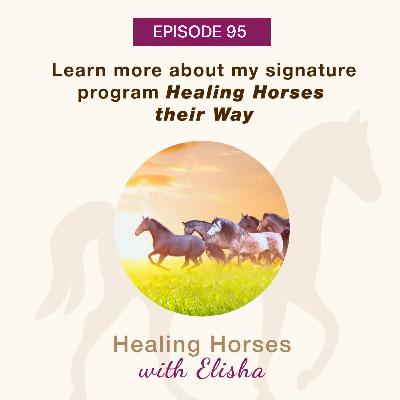
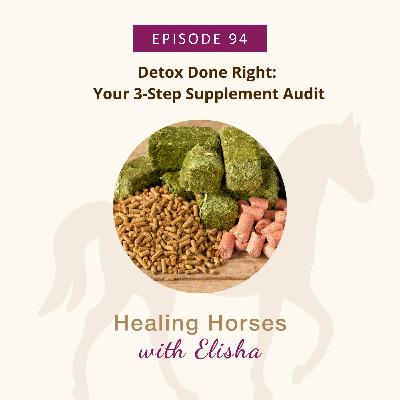
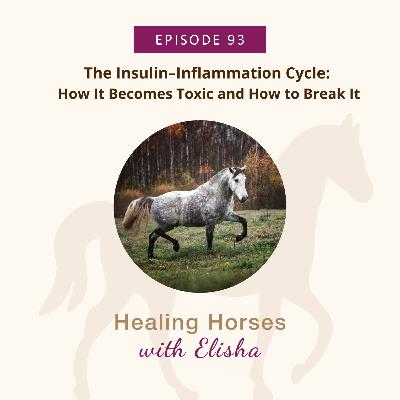
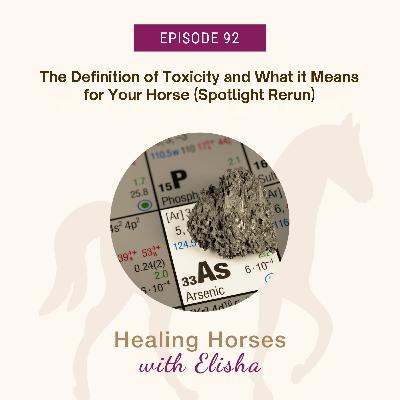

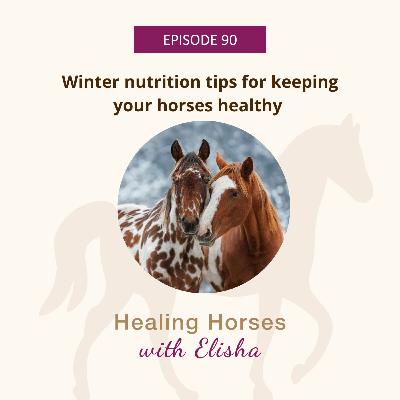



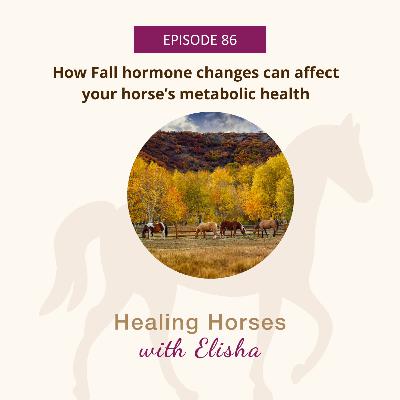
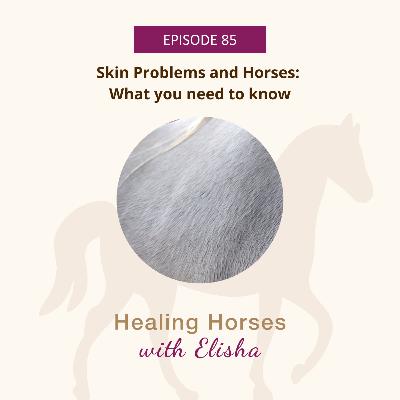
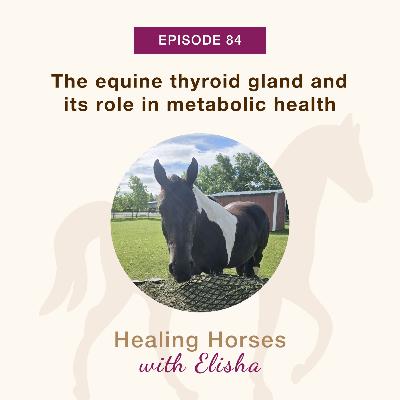
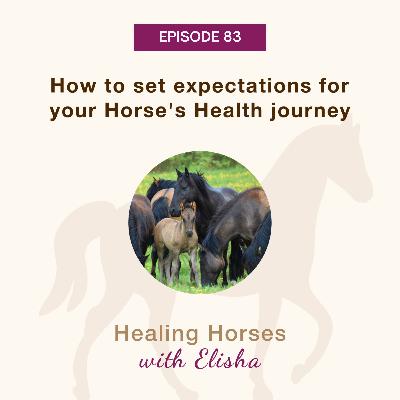
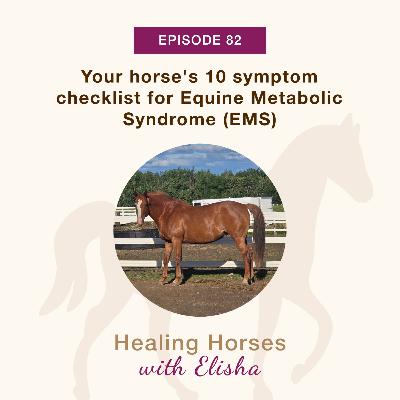
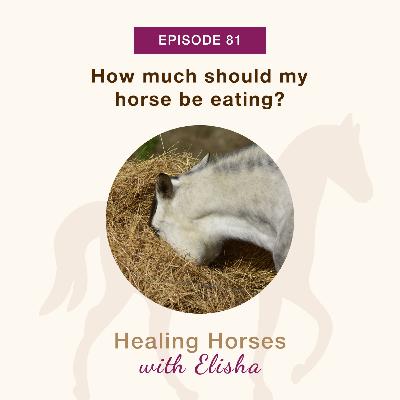
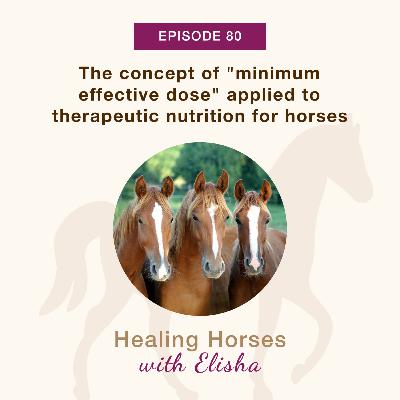
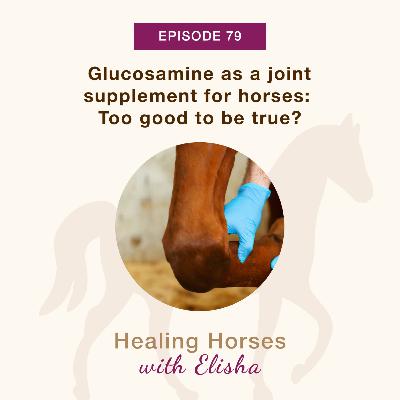

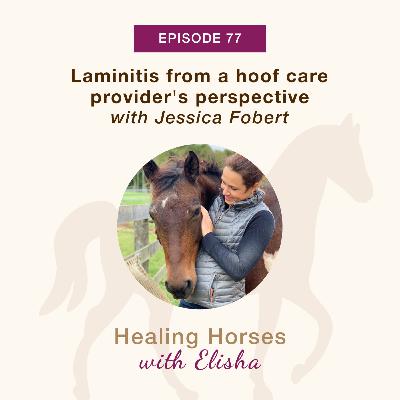
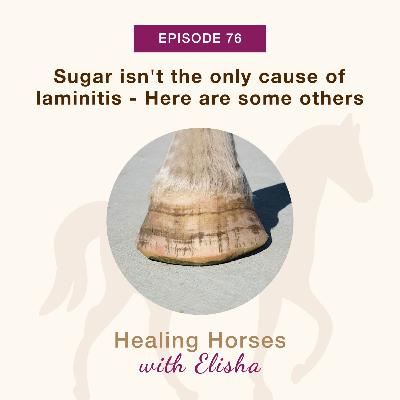



thank you for all the helpful information...I am also seeing all the changes in my 18 year old Mare for the better after switching to your recommendations vs. medication....